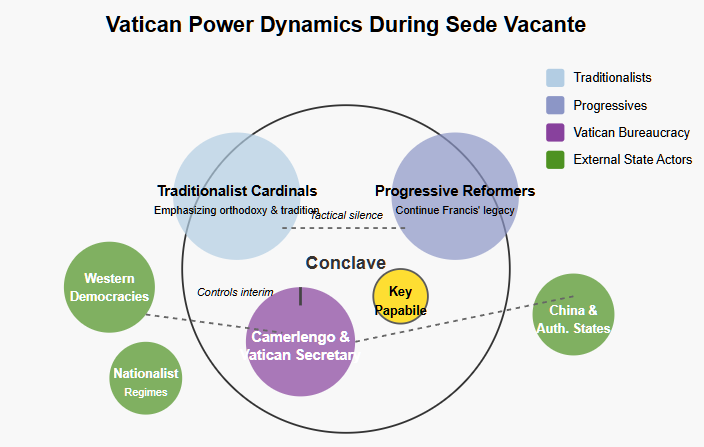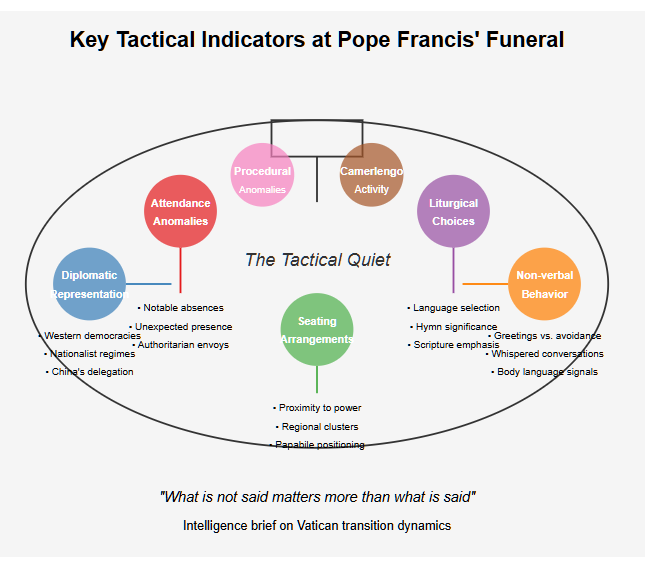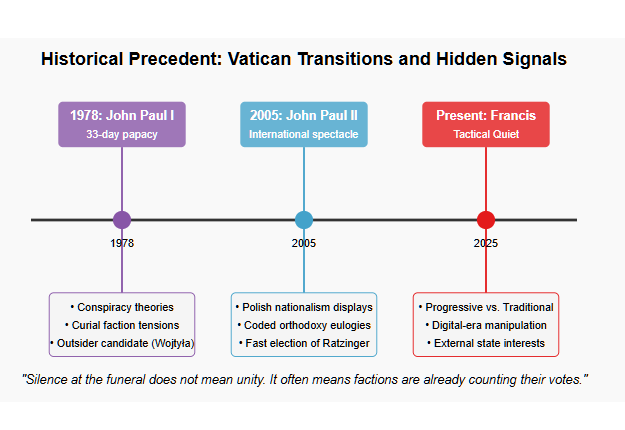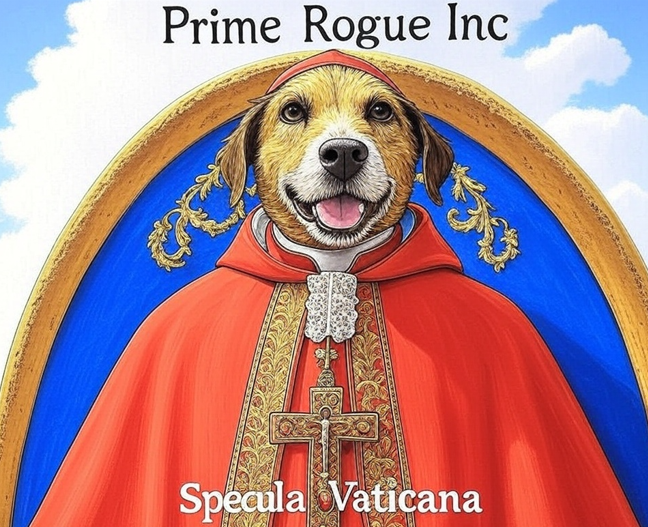I. Introduction: The Stillness Before Strategy
The Vatican tonight is cloaked in a stillness that feels reverent — but under the surface, it is pure strategy. As the funeral of Pope Francis approaches, the Church enters not just a period of mourning, but the first phase of a global power recalibration. In Vatican politics, silence is never neutral. It is tactical.
This post is not a eulogy. It is an OSINT field brief for those tracking the real implications of the Francis Vatican Funeral Tactical Quiet. Tomorrow’s ceremony will project unity, tradition, and reverence — but beneath the pageantry, the future of the Church is already being contested in whispers, seating charts, diplomatic absences, and coded gestures.
To understand what’s coming, you have to listen carefully — not to what is said, but to what is not.
II. Primary Intelligence Question: What Are the Factions Signaling?
In any Vatican transition, the most important intelligence question is simple: what are the factions signaling before the world realizes the battle has begun? The death of a pope is never just an ending. It is a moment of intense recalibration among bishops, cardinals, states, and ideologies — and every visible act, or conspicuous silence, carries meaning.
As we approach the Francis Vatican Funeral Tactical Quiet, observers must resist the temptation to view the event as merely ceremonial. The funeral will be the first global stage where traditionalists, progressives, Vatican bureaucrats, and external state actors begin to position themselves — not openly, but through coded behaviors, alliances, and omissions.
The real intelligence objective tonight is not to predict who mourns most visibly. It is to identify which networks are already recalculating, regrouping, and quietly preparing for the most consequential conclave since 2005.

III. Key Tactical Indicators to Watch at the Funeral
At first glance, a papal funeral appears uniform: sorrowful liturgy, solemn procession, orderly reverence. But for trained eyes tracking the Francis Vatican Funeral Tactical Quiet, the real action happens below the surface — in absences, glances, and whispered alliances. Here are the key indicators intelligence watchers must monitor tomorrow:

Attendance Anomalies
Not everyone will attend — and those who do (or do not) will matter.
Watch for:
- Notable absences among traditionalist cardinals or progressive reformers.
- Unexpected presence of retired, sidelined figures signaling factional comebacks.
- Authoritarian states sending high-ranking envoys (or snubbing altogether).
Diplomatic Representation
The funeral draws not just clergy but heads of state and diplomats.
Key questions:
- Are major Western democracies (e.g., Germany, U.S., France) represented at the highest level?
- Are nationalist or populist regimes (Hungary, Poland, Brazil) visibly asserting presence?
- Is China’s delegation present — and at what rank?
Diplomatic posture will hint at how different governments hope to influence the coming conclave indirectly.
Seating Arrangements
The Vatican treats seating as political cartography.
- Proximity to the Camerlengo or Vatican Secretary of State suggests influence.
- Clustering of regional blocs (African bishops, German reformers, U.S. traditionalists) reveals active or emerging alliances.
- Where will the Papabile, like Pierbattista Pizzaballa, be seated?
A sharp-eyed scan of the front sections can predict tomorrow’s voting blocs.
Liturgical Choices
Liturgy is never neutral in times of transition.
Pay close attention to:
- Language choices (Latin, Italian, or multi-lingual readings).
- Hymn selections signaling theological continuity or reformist outreach.
- Scriptural readings emphasizing mercy vs judgment — a coded nod to Francis’ contested legacy.
Non-verbal Behavior
Vatican politics are often conducted in nods and silences.
- Warm greetings versus cold shoulders among cardinals are indicators.
- Watch for long whispered conversations during the processions or recessional.
The conclave alliances are already forming — the body language will show it first.
Behavior of the Camerlengo
The Camerlengo administers the sede vacante — but how actively?
Signs of unusual assertiveness, visible coordination, or public gestures hint at who controls the Vatican’s interim machinery. If the Camerlengo is unusually visible, he’s likely already maneuvering.
Procedural Anomalies
Unexpected changes — minor liturgical adjustments, tightened conclave security protocols, or unusual Vatican press statements — suggest fractures behind the scenes.
In normal transitions, no news is good news.
In this conclave, too much silence may be a sign of coming rupture.
IV. Historical Precedent: When Vatican Funerals Forecasted Crisis
The Vatican thrives on ritual, but its most volatile transitions have often begun with funerals that looked serene on the surface — and masked upheaval underneath.

In 1978, the sudden death of John Paul I after only 33 days triggered an explosion of conspiracy theories. The funeral, while solemn, was already laced with suspicion: whispers of foul play, unspoken tension among curial factions, and the quick pivot toward the outsider candidacy of Karol Wojtyła (John Paul II) showed how fragile the system could become under a thin veil of liturgy.
In 2005, John Paul II’s funeral was an international spectacle — but behind the scenes, ideological lines hardened. Public displays of Polish nationalism, combined with coded eulogies emphasizing orthodoxy, signaled the strength of Cardinal Ratzinger’s bloc. Within weeks, the conclave produced one of the fastest papal elections in modern history — but only after fierce internal maneuvering.
The lesson for today’s Francis Vatican Funeral Tactical Quiet is clear: silence at the funeral does not mean unity.
It often means factions are already counting their votes.
V. Risk Factors: Where Tactical Silence Can Conceal Strategic Movements
The Francis Vatican Funeral Tactical Quiet may feel orderly — but intelligence watchers know that beneath the public ritual, real fractures can deepen in silence. Here are the primary risk factors that could escalate once the conclave window opens:
Pre-Conclave Meetings
Even before the conclave formally begins, private dinners, embassy receptions, and backroom negotiations are already reshaping alliances.
- Key hotels in Rome often host these informal caucuses.
- Embassies — particularly from major Catholic states like Italy, Spain, Poland — act as quiet diplomacy hubs.
These pre-conclave deals can lock voting blocs before the Sistine Chapel doors even close.
Media Narrative Priming
Tonight and tomorrow, major Catholic media outlets and influencers will begin framing the funeral — and the coming conclave.
- Traditionalist platforms may push the “restoration” narrative: a need to correct Francis’ perceived errors.
- Progressive media may call for “reform acceleration” — using Francis’ legacy as justification.
- Secular outlets may emphasize Vatican instability or corruption.
Whichever narrative dominates the next 72 hours will shape public (and internal) expectations going into the conclave.
False Consensus Risk
Funerals project unity — but it can be dangerously artificial.
- Cardinals may publicly praise Francis while privately maneuvering to reverse his reforms.
- Early conclave ballots often reveal that surface unity masked bitter divisions.
Do not mistake ceremonial cohesion for electoral cohesion.
External Intelligence Activity
Authoritarian regimes, hostile actors, and opportunistic influence operations are already active.
- Expect bot-amplified conspiracies: invalid election rumors, false conclave leaks, deepfake videos.
- Early disinformation could target specific papabile to smear reformist or traditionalist candidates.
This is not hypothetical — during the 2020s, both Russia and China expanded religious disinformation operations targeting Catholic and Protestant groups.
In this conclave cycle, the digital war for the Church’s soul has already begun — silently.
VI. Conclusion: Vigilance Over Reverence
The funeral of Pope Francis marks not the end of an era, but the beginning of a strategic recalibration within the Church.
The Francis Vatican Funeral Tactical Quiet unfolding tomorrow will offer few overt declarations — but for trained observers, the real movements will be clear in absence, posture, and coded ritual.
To the outside world, Rome will present unity, tradition, and dignity.
But inside the walls, factions are maneuvering, alliances are forming, and the future of Catholic global influence is already being contested.
This is not a moment for sentimentality. It is a moment for vigilance.
As the conclave window opens, remember:
In Vatican transitions, the silence between the words speaks louder than the words themselves.
And tomorrow’s silence will echo across the next generation of Catholic — and global — history.

[…] With the papal conclave set to begin on May 7, 2025, after the death of Pope Francis, and the Camerlengo’s interim administration of the Vatican nearing its close, the Church—and the world—awaits the emergence of a new pope. In this moment of transition, we turn back to the life and rule of Pope Francis, a reluctant pontiff who nevertheless governed the Vatican and the Holy See with the steely tactical discipline one might expect from a Jesuit forged in the fires of Argentina’s Dirty War. […]